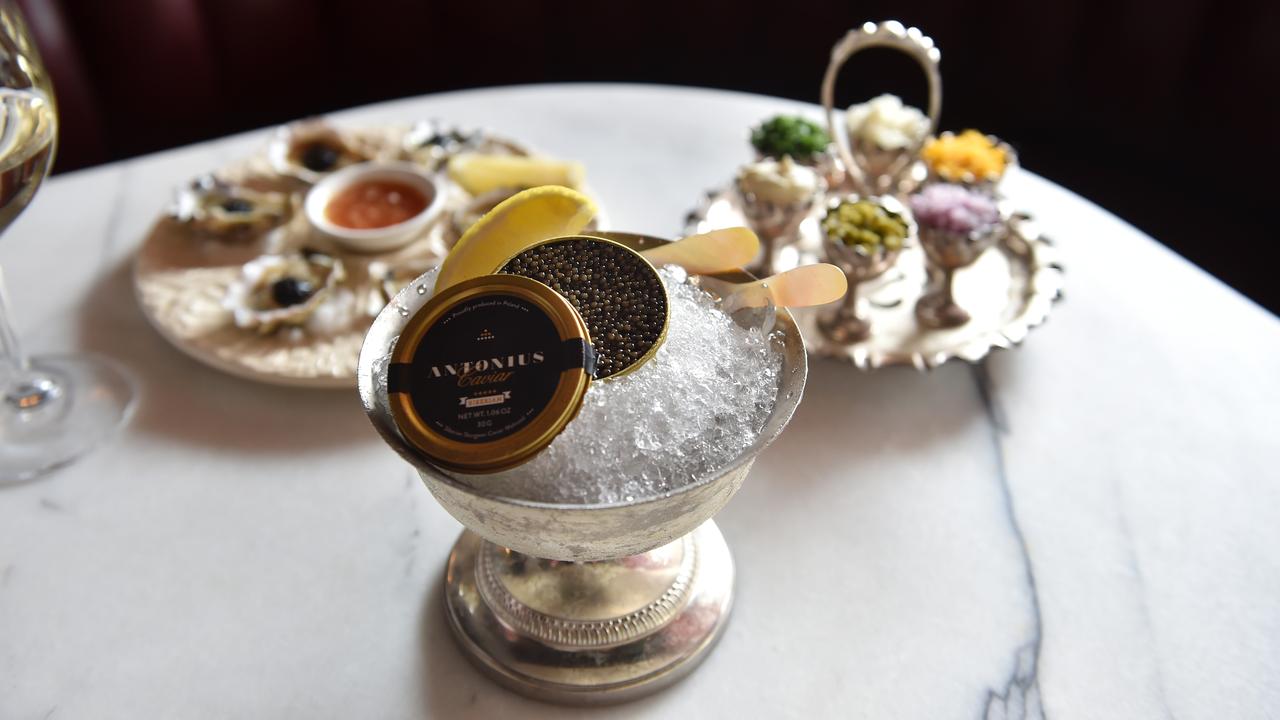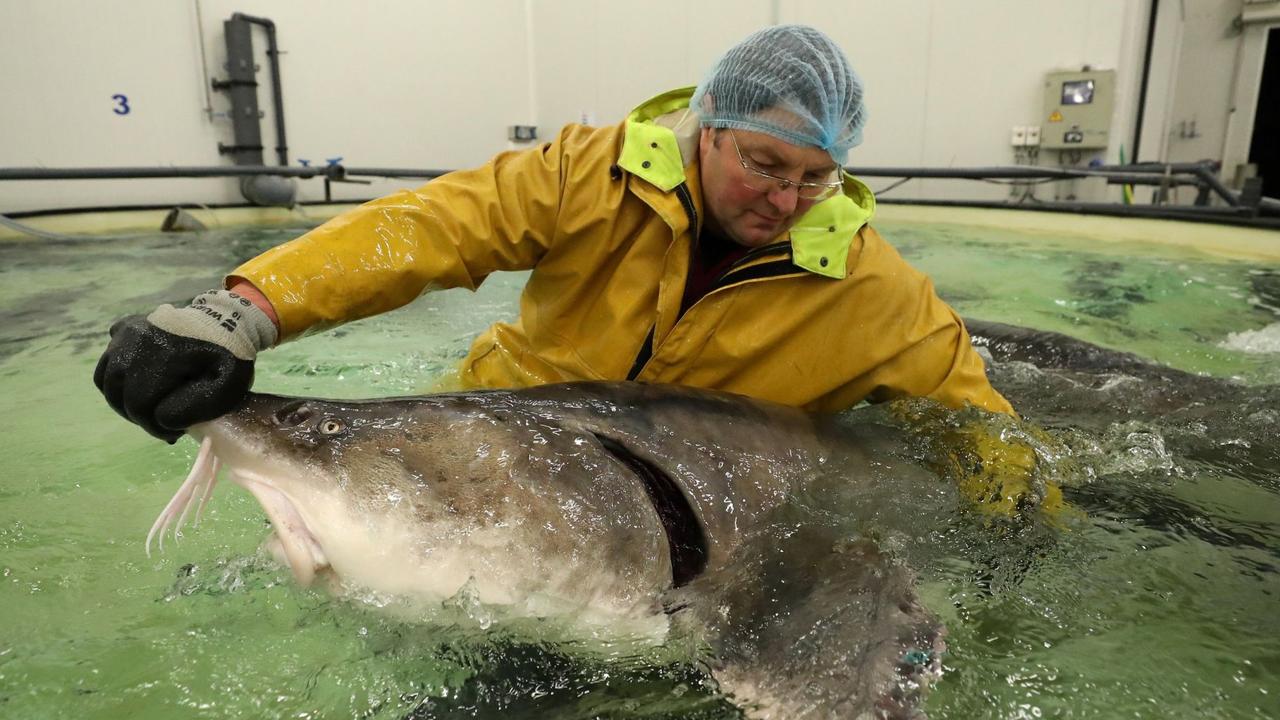
Dressed in a crimson blazer, David Williams reclines into a burgundy leather seat at Collingwood’s Smith Street Bistrot where chef Victor Blain serves him the restaurant’s caviar service.
Like the best champagne, the dish is synonymous with luxury and extravagance. But not so much today, says Mr Williams – one of Australia’s prominent agribusiness bankers – as he spreads a dollop on to a Merimbula oyster.
“(Last year) was all about entrees of yellowtail kingfish but 2023 is all about bringing caviar to a wider audience,” he says.
“The $300 jars with all the condiments have always been off limits to all but the very wealthy. Now it’s everywhere in bite-size and affordable dollops.” A few days later, he discovered that Qantas was serving caviar on a flight to New York. There were even bars serving it on potato chips. “Caviar,” Mr Williams says, “is the new black”.

But as tastes change and restaurants like Smith Street Bistrot and Mimi’s in Sydney – which has turned caviar into a pie with scallop mousseline – transform the dish, there is a problem.
While Australia positioned itself well to capitalise on the kingfish boom, albeit partially by accident when some attempts to farm bluefin tuna failed, every ounce of caviar is imported.
What’s more, beluga sturgeon, which produces the most valuable roe and is primarily found in the Caspian Sea, is endangered from decades of overfishing, habitat loss and the illegal trade of caviar.
But in Adelaide, a public servant has found a solution.
Mehdi Doroudi, chief executive of South Australia’s Department of Primary Industries, has been working with the commonwealth for the past decade to allow the importation of sturgeon and a final decision is expected soon.
The federal government is in the final stages of completing biosecurity risk assessments and consultation. Once approved, Professor Doroudi could issue licences under strict conditions, that would create Australia’s first homegrown caviar industry.
“It was a huge effort,” says Professor Doroudi, who worked in the Caspian Sea region and caviar industry in Iran before he emigrated to Australia 27 years ago.
“There are other countries where the sturgeon is not endemic but they import them and grow them in a biosecurity way. And I thought, why not here?”
While Tasmania gets most of the attention in relation to Australian aquaculture, SA has become the nation’s commercial fishery capital, fattening tuna in pens and farming kingfish, barramundi, rainbow trout, oysters and now potentially beluga sturgeon.
The caviar market presents a major opportunity. It is worth about $US276m ($409m) and that is expected to soar to $US1.88bn in the next five years with an annual growth rate of 9 per cent, according to Market Data Forecast.
But competition is increasing. More than half of the world’s commercial caviar farms are in China, where companies including Kaluga Queen sold their first tin 2006.
The cost of production is also high. Sturgeon farms cost millions of dollars to establish, given the fish needs cool, deeper water.
Professor Doroudi says that unlike carp, sturgeon would not survive in the Murray River or even Australia’s coastal waters.
Crucially, it takes more than a decade for a fish to reach maturity and harvest the first batches.
Mr Williams says: “The single biggest issue I see is that sturgeon is like almonds and walnuts, they can take up to 12 years to mature.
“I am not sure capital markets are that patient. However, they have done it in tree nuts, so maybe here also. The Germans and others have learned how to do it, so why not us,” Mr Williams says.

Australia’s reputation as a clean and green food producer also gives it an advantage, with interest in the nation’s aquaculture assets increasing, following the Tassal’s $1.7bn takeover from Canadian seafood giant Cooke, and Brazilian conglomerate JBS’s $425m acquisition of Huon.
Australian aquaculture is also expanding into new species, farming prawns in recent years and even the nation’s biggest fish, Murray cod, offering a more efficient way to help meet surging global demand for protein as well as higher culinary standards.
“There is lots to like about an Australian-grown caviar for the export market,” says Mr Williams, who bought Tassal for $42.5m after it fell into administration 20 years ago before floating it on the ASX, and then advised Cooke on its acquisition of the company.
“Sturgeon is under threat in certain parts of the northern hemisphere so new ideas to farm it are worth a look.”
Several big names, with equally big pockets, are understood to be interested in applying for licences to import and farm sturgeon in Australia, although Professor Doroudi declined to name those who have approached his office.
“It needs to stack up for investors,” he says, adding that one type of caviar – Almas from the Caspian Sea – sells for $12,000 to $14,000 a kilogram.
“It’s crazy when you think about it, but you need to be patient for 10 to 12 years before you can get caviar from the fish.” But Professor Doroudi says that doesn’t mean that investors cannot generate a return in the meantime.
He says an ideal model is to farm sturgeon, which can grow up to 7m long, for its meat which he says is unlike other fish.
“It’s not similar to anything that we are familiar with here. It’s not salmon, it’s not a snapper, it’s not a King George whiting but it’s nice eating, it’s good eating,” he says. “For many years, many countries have grown, in aquaculture, a sturgeon for the meat. If you look at China, they are producing thousands of tonnes of Siberian sturgeon (meat).”
This compares with global caviar production of about 380 tonnes, according to the European Union’s latest estimates.
“But even if you produce 100kg of that, if you could sell it for around $10,000 (a kilogram), it would be a significant amount in terms of return,” Professor Doroudi says. “I’ll leave that to the business people to run it the way they want to. But if they come to me for my aquaculture expertise and ask how we should do it … I’d say put part of your production into meat production and get cashflow, and maintain the good ones and quality ones through genetic selection.”

Investors could also gain a greater return from adopting roe harvesting practices that do not involve killing the fish. “That way the fish can continue to reproduce,” Professor Doroudi says.
“A lot could be done. It’s really an amazing area to be involved and needs a lot of passion from people who are coming in.
“If someone is after a quick cash return and says ‘I’ll put my money here, I want to see something tomorrow’, it would be wrong to step into this area.”
The idea of using surgical roe extraction techniques rather than killing a fish appeals to Mr Williams but he has a different view to Professor Doroudi about growing sturgeon for meat.
“I look at it as fish farmed for caviar only and harvested annually without having to sacrifice the fish. You can eat the fish, but the main prize is caviar,” he says, adding it was worth the wait.
“The difference between caviar, almonds and walnuts is that one is an aphrodisiac … clue: try the caviar pie at Mimi’s or the Caviar oysters at 300 Smith Street Bistrot,” Mr Williams says.
